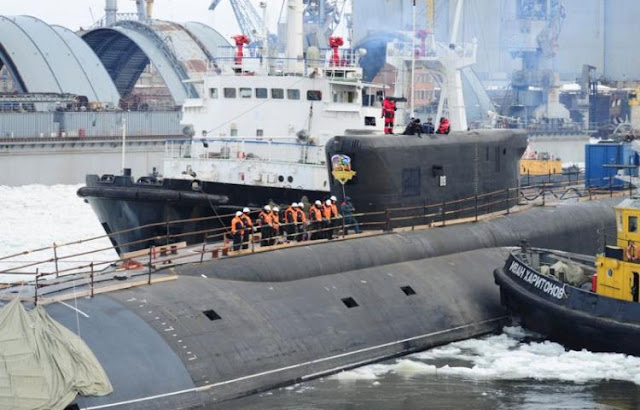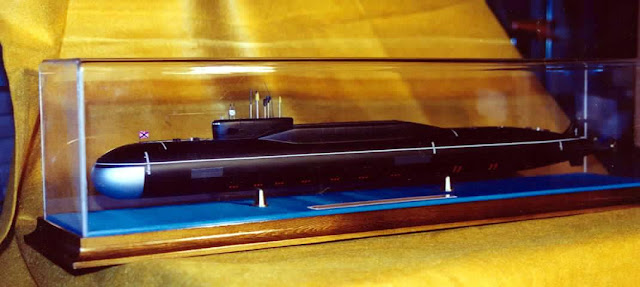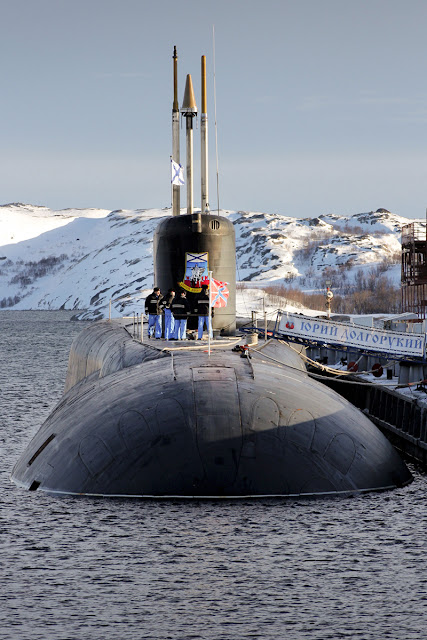Le unità appartenenti alla classe Borei (progetto 955) (NATO Reporting Name: Dolgorukiy class) sono sottomarini nucleari lanciamissili balistici di fabbricazione russa. Si tratta dei primi mezzi di questo tipo progettati e costruiti dopo il crollo dell'URSS.
Lo sviluppo è andato molto a rilento a causa di motivazioni sia tecniche, sia economiche. Il primo esemplare, varato nel 2007, ha ricevuto la bandiera ed è entrato in servizio il 10 gennaio 2013.
Sviluppo
La costruzione di una nuova generazione di SSBN venne annunciata dai vertici della Marina Russa il 16 ottobre 1996. Il 2 novembre dello stesso anno, presso il cantiere navale Sevmaš (Severodvinsk) vennero iniziati i lavori della prima unità della classe Borei (all'epoca nota come progetto 935). Il nome del sottomarino era Jurij Dolgorukij, il principe russo che secondo la tradizione ha fondato la città di Mosca (città che ha sponsorizzato il sottomarino).
Nelle intenzioni dei vertici della Marina Russa, avrebbe dovuto affiancare i classe Typhoon, rispetto ai quali avrebbe avuto dimensioni minori ma un armamento simile.
L'ingresso in servizio era inizialmente previsto per il 2001, ma la costruzione è stata caratterizzata da pesanti ritardi, dovuti a motivi sia economici sia tecnici. Tra questi ultimi, in particolare, determinante è stato il totale insuccesso del missile che avrebbe dovuto imbarcare la nuova classe di sottomarini. I primi tre lanci di tale missile, l'SS-NX-28, fallirono e questo provocò la cancellazione del nuovo sistema d'arma.
A causa di questo fallimento, fu necessario provvedere ad una radicale opera di riprogettazione del sottomarino, in seguito alla quale assunse l'attuale denominazione di progetto 955. Le modifiche al progetto prevedevano, ovviamente, l'utilizzo di un nuovo missile, l'SS-N-30 Bulava (versione navale SLBM dell'ICBM SS-27 Stalin).
L'ingresso in servizio venne continuamente posticipato, fino a quando, nell'agosto del 2003, i vertici militari russi dichiararono che la piena operatività dei Borei si sarebbe avuta nel 2010, fondi permettendo. In quel periodo, il sottomarino era completo al 40%.
Il varo del primo esemplare, largamente incompleto, avvenne il 15 aprile 2007. Per la Russia era un evento molto importante, poiché si trattava del primo SSBN dal 1990 (anno del varo del K-407 Novomoskovsk, ultimo esemplare della Delta IV). Inoltre, si tratta del primo battello di questo tipo russo e non sovietico. La consegna della bandiera e l'entrata in servizio è stata effettuata il 10 gennaio 2013.
Tecnica
Tecnicamente, secondo le dichiarazioni dei vertici della Marina Russa, i Borei rappresenterebbero lo stato dell'arte per quanto riguarda questa tipologia di sottomarini, e sarebbero superiori agli altri tipi attualmente in servizio. In particolare, grazie ad una nuova forma dello scafo e ad un sistema propulsivo innovativo, sarebbero estremamente silenziosi e, quindi, poco rintracciabili ai sonar.
Il costo stimato di un singolo esemplare è di 890 milioni di dollari. La velocità in immersione stimata dovrebbe essere pari a 29 nodi.
Armamento
Per quanto riguarda la fase progettuale, l'armamento è sicuramente quello che ha dato più problemi. Infatti, inizialmente i Borei avrebbero dovuto imbarcare venti SS-NX-28, derivati dagli SS-N-20 Sturgeon imbarcati sui Typhoon. Tuttavia, il fallimento di tale sistema d'arma ha costretto i tecnici a riprogettare largamente il sottomarino, ed a sviluppare un nuovo sistema missilistico.
Nello specifico, oggi i Borej imbarcheranno gli SS-N-30 Bulava, che però, essendo di derivazione terrestre, hanno un ingombro superiore agli SS-NX-28 previsti nel progetto originale. Di conseguenza, il numero dei missili imbarcabili è stato ridotto, passando dai venti inizialmente previsti a dodici. Successivamente, comunque, con il Progetto 955/A è stato possibile portare il loro numero agli attuali sedici.
Durante i test, uno spettacolare fallimento si è verificato nella notte dell'8 dicembre 2009, quando un missile fuori controllo ha disegnato delle spirali nel cielo della Norvegia, mettendo in allarme una base militare anche per la concomitanza della presenza di Barack Obama ad Oslo per la cerimonia del ritiro del premio Nobel.
Nel giugno 2018 i Bulava sono entrati ufficialmente in servizio nella Marina russa a seguito del successo nel lancio simultaneo di una salva di 4 missili avvenuto nel maggio 2018. Per quanto riguarda i siluri, sono previsti sei tubi da 533mm.
Esemplari previsti
È prevista la costruzione di otto esemplari entro il 2020, tre come Progetto 955, e cinque come Progetto 955/A (aumentato il contenimento del rumore e con 20 missili balistici intercontinentali Bulava come dotazione).
Al momento, sono stati varati tre esemplari e ne risultano in costruzione quattro, presso il cantiere Sevmaš a Severodvinsk.
Il Cantiere Navale Sevmash Shipyard ha previsto di varare entro Aprile 2020 il Knyaz Vladimir. Il Knyaz Vladimir è la versione migliorata del sottomarino subacqueo strategico missilistico Project 955, che rappresenta la quarta generazione di sottomarini a propulsione nucleare costruiti per la Marina russa. È stato lanciato nel novembre 2017. Secondo i dati del ministero della Difesa russo, il sottomarino Knyaz Vladimir è meno rumoroso e presenta migliori sistemi di controllo delle manovre, della profondità e degli armamenti.
Tutti i sottomarini di classe Borei possono trasportare 16 missili balistici Bulava. Sono inoltre dotati di tubi siluro da 533 mm.
ENGLISH
The Borei class, alternate transliteration Borey, Russian designation Project 955 Borei and Project 955A Borei-A, (Russian: Борей, meaning "Boreas, NATO reporting name Borei), also referred to as Dolgorukiy class, are series of nuclear-powered ballistic missile submarines being constructed by Sevmash for the Russian Navy. The class is projected to replace the Soviet-era Delta III, Delta IV and Typhoon classes in Russian Navy service.
Despite being a replacement for many types of submarines, the Borei-class submarines are much smaller than those of the Typhoon class in both volume and crew (24,000 tons opposed to 48,000 tons and 107 people as opposed to 160 for the Typhoons), and are in terms of class more accurately a follow-on to for the Delta IV-class SSBNs.
History
The first design work on the project started in the mid-1980s and the construction of the first vessel started in 1996. Previously, a short-lived, smaller parallel design appeared in 1980s with designation Project 935 Borei II. A new submarine-launched ballistic missile (SLBM) called the R-39UTTH Bark was developed in parallel. However, the work on this missile was abandoned and a new missile, the RSM-56 Bulava, was designed. The submarine needed to be redesigned to accommodate the new missile, and the design name was changed to Project 955. The vessels were developed by Rubin Design Bureau are being built by Russia's Northern shipyard Sevmash in Severodvinsk. Because of the repeated failures during Bulava test launches, some experts suggested that the Borei submarines could instead be armed with R-29RMU Sineva SLBMs, already in active duty with the Delta IV-class submarines.
It has been reported that the arrival of the Borei class will enable the Russian Navy to resume strategic patrols in southern latitudes that have not seen a Russian missile submarine for 20 years.
Launch and trials
The launch of the first submarine of the class, Yury Dolgorukiy (Юрий Долгорукий), was scheduled for 2002 but was delayed because of budget constraints. The vessel was eventually rolled out of its construction hall on 15 April 2007 in a ceremony attended by many senior military and industrial personnel. Yuriy Dolgorukiy was the first Russian strategic missile submarine to be launched in seventeen years since the end of the Cold War. The planned contingent of eight strategic submarines was expected to be commissioned within the next decade, with five Project 955 planned for purchase through 2015.
Although Yuriy Dolgorukiy was officially rolled out of its construction hall on 15 April 2007 the submarine was not put into the water until February 2008. By July 2009, it had yet to be armed with Bulava missiles and was therefore not fully operational, although ready for sea trials on 24 October 2008. On 21 November 2008 the reactor on Yuriy Dolgorukiy was activated and on 19 June 2009 began its sea trials in the White Sea.
In August 2009 it was reported that the submarine would undergo up to six trials before being commissioned but the problem with the Bulava missile could delay it even more.
On 28 September 2010 Yuriy Dolgorukiy completed company sea trials. By late October the Russian Pacific Fleet was fully prepared to host Russia's new Borei-class strategic nuclear-powered submarines. It is expected that four subs will be deployed in the Northern fleet and four subs in the Pacific fleet. On 9 November 2010 Yuriy Dolgorukiy passed all sea trials directed to new equipment and systems.
Initially, the plan was to conduct the first torpedo launches during the ongoing state trials in December 2010 and then in the same month conduct the first launch of the main weapon system, RSM-56 Bulava SLBM. The plan was then postponed to mid-summer 2011 due to ice conditions in the White Sea.
On 2 December 2010 the second Borei-class submarine, Alexander Nevskiy, was moved to a floating dock in Sevmash shipyard. There the final preparations took place before the submarine was launched. The submarine was launched on 6 December 2010 and began sea trials on 24 October 2011.
On 28 June 2011 a Bulava missile was launched for the first time from the Borei-class submarine Yuriy Dolgorukiy. The test was announced as a success. After long delays finally the lead vessel, Yuriy Dolgorukiy, joined the Russian Navy on 10 January 2013. The official ceremony raising the Russian Navy colors on the submarine was led by Russian Defense Minister Sergey Shoygu. It was actively deployed in 2014 after a series of exercises.
On 17 November 2017, the fourth Borei-class submarine and the first of the improved Project 955A, the Knyaz Vladimir was moved out of the construction hall at the SEVMASH shipyard. The submarine was launched a year later and subsequently started its factory trials.
Design
Borei class includes a compact and integrated hydrodynamically efficient hull for reduced broadband noise and the first ever use of pump-jet propulsion on a Russian nuclear submarine. The noise level is to be five times lower when compared to the third-generation nuclear-powered Akula-class submarines and two times lower than that of the U.S. Virginia-class submarines. The acoustic signature of Borey is significantly stealthier than that of the previous generations of Russian SSBNs, nevertheless the USN has been able to identify the main noise emitter, i.e. the hydraulic pump. As the pump ages, it tends to become noisier, allowing for easier detection of the submarine.
The Borei submarines are approximately 170 metres (560 ft) long, 13 metres (43 ft) in diameter, and have a maximum submerged speed of at least 46 kilometres per hour (25 kn; 29 mph). They are equipped with a floating rescue chamber designed to fit in the whole crew. Smaller than the Typhoon class, the Boreis were initially reported to carry 12 missiles but are able to carry four more due to the decrease in mass of the 36-ton Bulava SLBM (a modified version of the Topol-M ICBM) over the originally proposed R-39UTTH Bark. Cost is some ₽23 billion (USD$890 million), in comparison the cost of an Ohio-class SSBN was around US$2 billion per boat (1997 prices).
Each Borey includes of 1.3 million units and mechanisms. Its construction requires 17 thousand tons of metal which is 50 % more than the Eiffel Tower. The total length of pipelines is 109 km and the length of cable routes is 600 km. 10 thousand rubber plates cover the hull of the boat.
Versions
Project 955A (Borei-A)
Units of the Project 955A include improved communication and detection systems, improved acoustic signature and have major structural changes such as addition of all moving rudders and vertical endplates to the hydroplanes for higher maneuverability, and a different sail geometry. Besides, they are equipped with hydraulic jets and improved screws what allows them to sail at nearly 30 knots while submerged with minimal noise. Although first reported to carry 20 Bulava SLBMs, the 955A will be armed with 16 SLBMs with 6-10 nuclear warheads atop each, just like the project 955 submarines.
The contract for five modified 955A submarines was delayed several times due to price dispute between the Russian Defence Ministry and the United Shipbuilding Corporation. The contract was formally signed on 28 May 2012.
The first 955A submarine, Knyaz Vladimir, was laid down on 30 July 2012, during a ceremony attended by the Russian President Vladimir Putin. Two additional project 955A submarines were laid down in 2014, one in late 2015, and one in late 2016.
According to Sevmash official, Vitaliy Bukovskiy, all Borei-A submarines are to be equipped with aspen banyas able to accommodate 3-4 people.
Project 955B (Borei-B)
The Project 955B was expected to feature a new water jet propulsion system, an upgraded hull, and new noise reduction technology. The concept design was to be initiated by the Rubin Design Bureau in 2018 and four project 955B boats were been proposed with first unit to be delivered to the Russian Navy in 2026. However, the project wasn't reportedly included in the Russia's State Armament Programme for 2018–2027 due to cost-efficiency. Instead, six more Borei-A submarines were to be built after 2023. According to a 2018 report, Russia's State Armament Programme for 2018–2027 includes construction of two more Borei-A submarines by 2028. The construction should take place at Sevmash starting in 2024 with deliveries to the Russian Navy in 2026 and 2027 respectively.
Borei-K
A proposed version armed with cruise missiles instead of SLBMs, similar to the American Ohio-class nuclear-powered cruise missile submarines (SSGNs), is under consideration by the Russian Defence Ministry.
(Web, Google, Wikipedia, CovertShores, You Tube)

















































